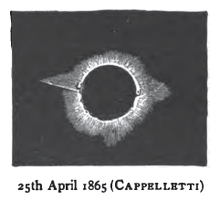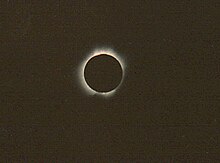

Series member 29

Series member 30

Series member 32

Series member 36

Series member 37
Saros cycle series 136 for solar eclipses occurs at the Moon's descending node, repeating every 18 years, 11 days, containing 71 eclipses, 56 of which are umbral (6 annular, 6 hybrid, 44 total). The first eclipse in the series was on 14 June 1360 and the last will be on 30 July 2622. The most recent eclipse was a total eclipse on 22 July 2009 and the next will be a total eclipse on 2 August 2027.
The longest totality was 7 minutes 7.74 seconds on 20 June 1955 (also the longest total eclipse of the 20th century) while the longest annular eclipse was just 32 seconds on 8 September 1504.
This series is currently producing the longest total solar eclipses of any active series. It produced the six longest total solar eclipses of the 20th century, three of them over seven minutes long.[2] It also produced the longest total eclipse of the 21st century at 6 min 38.86 sec on 22 July 2009, and overall will produce the 21st century's three longest total eclipses. Each eclipse is getting slightly shorter and this series will be surpassed in total eclipse length by Solar Saros 139 (whose eclipses are getting slightly longer) on May 11, 2078.[3] Saros 136 in turn surpassed the previous longest-eclipse series, Saros 133, with its member event on May 18th, 1901. It produced the most central total eclipse between the years 1209 and 2718 and the greatest magnitude of any eclipse since the year 540 on July 11, 1991.
This solar saros is linked to Lunar Saros 129.
- ^ In 1883 an expedition of American astronomers traveled from Peru to Caroline Island aboard the USS Hartford to observe the May 6 total solar eclipse. A French expedition also observed the eclipse from Caroline. "Archived copy". Archived from the original on 2012-02-19. Retrieved 2017-07-14.
{{cite web}}: CS1 maint: archived copy as title (link) - ^ "Catalog of Solar Eclipses: 1901 to 2000". eclipse.gsfc.nasa.gov. Retrieved 2024-04-09.
- ^ "Catalog of Solar Eclipses: 2001 to 2100". eclipse.gsfc.nasa.gov. Retrieved 2024-04-09.